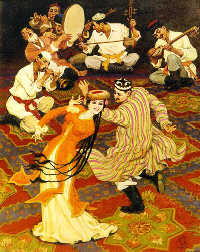| |
Sanam Dance
( 2005-09-13 )
 Sanamis the most popular folk dance among all the Uygurs in Northwest China'sXinjiangUygur Autonomous Region. It mainly originated in southern Xinjiang with its advanced agriculture and culture and a dense population of Uygurs. In forming the Uygur classic music called the Twelve Muqam,Sanamwas included, meaning it must be even older than the centuries-old Muqam. At the same timeSanamwas popularized among the Uygurs as an independent dance. Sanamis the most popular folk dance among all the Uygurs in Northwest China'sXinjiangUygur Autonomous Region. It mainly originated in southern Xinjiang with its advanced agriculture and culture and a dense population of Uygurs. In forming the Uygur classic music called the Twelve Muqam,Sanamwas included, meaning it must be even older than the centuries-old Muqam. At the same timeSanamwas popularized among the Uygurs as an independent dance.
At weddings, on festive occasions, and at parties people invariably danceSanam. For instance, at a song and dance party the whole village, old and young, men and women, relatives and friends, joins in the dance. One family plays host for each party. The dancing and singing are kept going with games of passing flowers, wine cups, or belts. Sometimes a performance of Muqam songs andriddlesor a recitation of poem is included.
On the first day of a wedding celebration, friends on both sides invite the bridegroom and their relatives to their homes. In the evening the bridegroom and his friends go to the bride's home to welcome the bride. A band plays as they go singing and dancing on their way. Throughout the daySanamis the main form of singing and dancing.
In a performance ofSanampeople sit in a circle with a band in one corner. As people clap their hands and sing in unison, the dancers dance. Besides singing the familiar old songs, they improvise new verses to old melodies to describe the festive scene and their joyous feelings.
The dancers also improvise, following the tempo of the music. One, two, three, or five people dance together. The tempo quickens gradually until music and dance reach their climax and people shout "Kai-na! (Come on!)" or "Balikaleila! (Wonderful!)" The shouting, drumming, and music create great excitement.
Since 1949, released from feudal ethics, the Uygur women have joined in the massSanamdance.
The movements are graceful, elegant, and varied, determined by the music, tempo, and occasion. The primary feature is coordination of different parts of the body -- head, shoulders, wrists, waist, and legs. For instance, head movements include turning the neck and shaking. The wrists revolve, cross, and perform wavelike movements. Waist movements include lifting the chest, turning sideways, bending backward. Leg movements are more varied, including pointing the toe, kicking backward, stamping, and turning.
|
|

